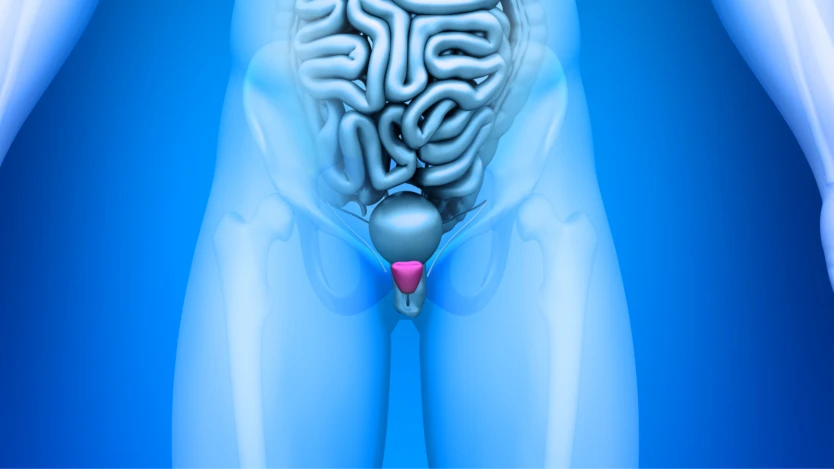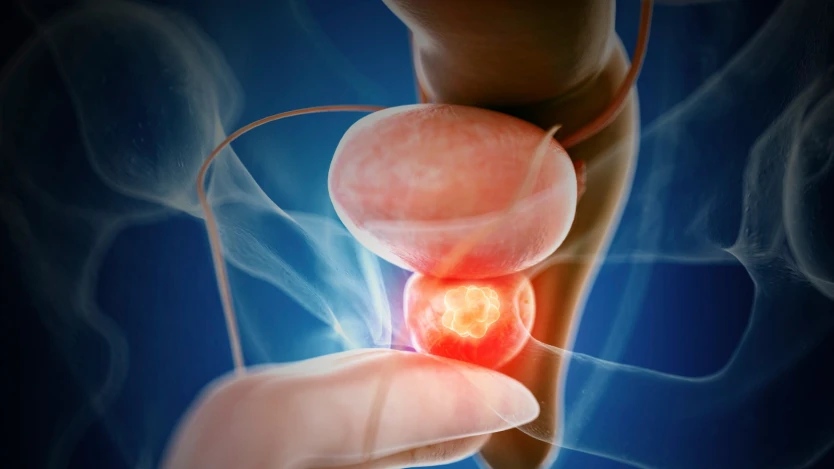Prostate problems, BPH, prostatitis, prostate cancer

- What types of prostate problems are there?
- How are prostate problems diagnosed?
- Treatment for prostate problems
- Prostate problems often cause an enlarged prostate and difficulty or pain during urination.
- Benign prostatic hyperplasia is the main cause of the most common prostate problems.
- To alleviate benign prostatic hyperplasia problems, the only definitive option is prostate surgery.
The prostate is a glandular organ of the male reproductive system. It is shaped like a chestnut and is located at the exit of the bladder, in front of the rectum and crossed by the urethra (which is the tube that connects the bladder with the outside).
The function of the prostate is to produce part of the seminal fluid necessary for the formation of semen, supplemented by the seminal fluid provided by the seminal vesicles.

Do you need prostate surgery?
Request a free and immediate appointment with our specialists in Urology
The seminal fluid provided by the prostate provides a number of nutrients to the sperm to enable them to carry out their function.
There are several common prostate problems, the most common of which is benign prostatic hyperplasia, a consequence of the enlargement of the prostate with age and the hormonal changes associated with this process. This prostate problem is not serious, but rather a rather annoying problem due to the urinary symptoms it causes.
Although the most common is benign prostatic hyperplasia, there are other prostate problems that are more or less serious.
What types of prostate problems are there?
As mentioned above, the main and most common prostate problem is benign prostatic hyperplasia (affecting around 528 million men worldwide and rising) although there are other prostate problems such as prostate cancer or prostatitis:
Prostatitis
Prostatitis is a prostate problem caused by inflammation of the prostate. It is important to differentiate an inflammation of the prostate due to prostatitis from an enlarged prostate caused by benign prostatic hyperplasia or prostate cancer.
There are several types of prostatitis depending on their symptoms and persistence.
Prostate problems caused by prostatitis are acute bacterial prostatitis, chronic bacterial prostatitis and chronic pelvic pain syndrome (which is non-bacterial prostatitis).
Symptoms of prostatitis
The symptoms of prostatitis can be similar to those of benign prostatic hyperplasia (difficulty urinating, difficulty emptying the bladder, increased urinary frequency, etc.) although it has other even more annoying symptoms.
The prostate problems derived from prostatitis will determine the type of prostatitis it is:
- Acute bacterial prostatitis: Symptoms are fever, discomfort when urinating similar to benign prostatic hyperplasia, itching when urinating and even difficulty urinating.
- Typical chronic bacterial prostatitis: This type of prostatitis is rare and is characterised by frequent episodes of urinary tract infection.
- Chronic pelvic pain syndrome: The symptoms are pain, problems during urination and loss of quality of life. The frequency of this type of prostate problem is quite common.

Benign prostatic hyperplasia
Benign prostatic hyperplasia is the prostate problem par excellence and the one that men are most likely to suffer from if they reach an advanced age. From the age of 40, but especially from 50 onwards, the size of the prostate begins to increase abnormally, largely due to the hormonal changes that men undergo as they get older.
This enlargement of the prostate leads to pressure on the urethral duct, which reduces the space in the urethra. This causes a series of urinary problems that are commonly known as prostate problems.
Benign prostatic hyperplasia is a benign prostatic pathology, which differentiates it from cancer, and there are numerous ways to treat it successfully.
Symptoms of benign prostatic hyperplasia
Prostate problems related to benign prostatic hyperplasia are usually mainly related to urination:
- Intermittent urination
- Urine retention in the bladder, difficulty in emptying the bladder completely
- Loss of urinary calibre and urinary force during urination
- Increased nocturnal urinary frequency
- Kidney problems, blood in the urine and urine infections in severe cases.
Treatments for benign prostatic hyperplasia always seek to solve prostate problems by relieving symptoms, with prostate surgery always being the only definitive option.

Prostate cancer
Prostate cancer is the most serious and the most feared of all prostate problems. It is important to say that if it is detected early, the chances of survival are very high.
This prostate problem originates in the glandular cells of the prostate, which are responsible for the production of seminal fluid, and is called adenocarcinoma. Although there are sarcomas, small cell carcinomas or transitional cell carcinomas, the most common type of prostate cancer is adenocarcinoma.
Most prostate cancers grow slowly, so it is easy to detect them through regular testing of men over the age of 40-50, although there are also cases where the cancer spreads rapidly, although these are rare. A curiosity is the fact that in many autopsies of elderly patients who have died for other reasons, prostate cancer that never affected them has been detected.
Symptoms of prostate cancer
Prostate cancer usually has no symptoms in its early stages, but as it progresses, it can present symptoms similar to prostate problems caused by benign prostatic hyperplasia:
- Problems with urination, decreased urinary strength and calibre, increased frequency of urination, especially at night, etc.
- Blood in the urine, although this does not mean prostate cancer, it may be an infection or kidney problems.
- Impotence, difficulty in getting an erection.
- Pain in the hips, chest, back and other areas due to the spread of cancer to the bones.
- Pain or numbness in legs, feet, loss of bladder or bowel control due to pressure from prostate cancer on the spinal cord.
There is no need to panic, as these symptoms can be caused by other conditions, but it is always advisable to visit your urologist regularly and discuss any symptoms or problems you may have.

How are prostate problems diagnosed?
Rectal examination
Rectal examination is perhaps the most important diagnostic test for the detection of prostate problems.
Through this test the doctor can differentiate between an enlarged prostate due to benign prostatic hyperplasia, a prostate affected by prostate cancer and an inflamed prostate due to prostatitis:
- Benign prostatic hyperplasia: If the patient presents symptoms related to urination, a digital rectal examination will be performed. In the case of BPH, the doctor will feel an elastic prostate instead of a soft one, which is the feel of a healthy prostate, and can also detect the size of the prostate.
- Prostate cancer: The feel of a prostate with prostate cancer is hard, noting rigid nodules. Rectal examination is the most important and useful test for detecting this medical problem.
- Prostatitis: In this case, on palpation of the prostate, the patient will feel pain, allowing the doctor to make a diagnosis.
IPSS Prostate Symptom Questionnaire
This test will allow the doctor to know the current health of the patient's prostate and the extent of any prostate problems he may have, giving him an indication of the possibility of prostate enlargement. If he/she considers this to be the case, he/she may order a blood test to determine the PSA levels in the blood and proceed to perform the aforementioned digital rectal examination.
PSA blood test
PSA is an antigen that is only produced by the prostate, increasing slightly in the blood as the size of the prostate increases. This test will help to confirm your previous diagnosis of BPH.
Urinalysis
One of the prostate problems mentioned is prostatitis, which may be caused by a bacterial infection in the prostate. If this is the case, the urologist will detect the infection in the urine analysis and can proceed with antibiotic treatment to resolve the symptoms.
Prostate ultrasound
Once the doctor has determined that the prostate problems are due to an enlarged prostate, a prostate ultrasound will be performed to determine the exact size of the prostate and determine the most appropriate treatment.
Prostate biopsy
This diagnostic test is performed to determine the presence of prostate cancer.
Treatment for prostate problems
Treatment of prostatitis
As mentioned above, prostatitis can be detected by a urine test. If the urologist detects bacterial infection, it is bacterial prostatitis and will most likely prescribe antibiotics and the symptoms will disappear at the end of the treatment.

On the other hand, there is non-bacterial prostatitis which is more complicated to treat. For this, the doctor may prescribe painkillers and alpha-blockers. The latter relaxes the muscle tissue of the prostate, thereby slightly relieving prostate problems. In addition to this, the doctor will have you change your diet and provide you with a series of instructions such as warm baths.
In many cases, the symptoms of prostatitis disappear on their own.
Benign prostatic hyperplasia treatment
Treatment for prostate problems caused by benign prostatic hyperplasia may involve the use of drugs or surgical treatment to reduce the size of the prostate.
In all cases, treatment for prostate problems caused by benign prostatic hyperplasia is aimed at relieving symptoms.
Below we will briefly discuss some of the surgeries for the treatment of prostate problems (BPH):
Prostate surgery with urethral release (Urolift System)
This is the only procedure currently available that relieves prostate problems caused by prostatic hypertrophy in an outpatient surgery lasting only 20 minutes, minimising possible complications and allowing patients to retain full sexual function, including ejaculation.
Symptomatic relief of prostate problems is immediate and no regional or general anaesthesia is required for this operation, only local anaesthesia and sedation, allowing the patient to leave the hospital on their own a few hours after the surgery.
Prostate surgery with urethral release (Urolift System) is performed with a device designed to access through the urethra to the prostate, place several implants in the areas blocking the urethra and thus alleviate prostate problems.
In addition, at the end of the intervention, the surgeon can insert an endoscope and see whether the urethral duct is completely free or whether another implant needs to be inserted.
To find out more about this innovative procedure, click on the following link: Urolift system Prostate surgery.

Do you need urolift prostate surgery?
Request a free and immediate appointment with our specialists in Urology
Thulium laser prostate surgery
Thulium laser prostate surgery is the newest laser procedure for the treatment of prostate problems related to benign prostatic hyperplasia. This technique can treat large prostates and works by introducing a fibre laser beam through the urethra and into the prostate.
Once there, the surgeon vaporises the enlarged prostate tissue, freeing the urethral duct.
Thulium laser vaporisation involves heating intracellular water to temperatures above 100 degrees, at which point it evaporates along with the rest of the cellular material. This technique allows the heat that is dispersed towards the tissue near the vaporised tissue to cause a haemostatic effect that minimises bleeding.
This reduction in bleeding reduces the length of hospital stay to just 1 day, minimises complications such as erectile problems or incontinence and allows for a much faster postoperative recovery than with conventional TURP, for example.
Treatments for prostate cancer
For the treatment of prostate cancer there are three main types of treatment: surgical removal of the prostate, radiotherapy and hormone treatment.

Radical prostate removal surgery
Prostate surgery involves the removal of the entire prostate gland, completely eliminating the cancerous cells.
This surgery can be performed openly or using minimally invasive laparoscopic techniques or with the Da Vinci robot.
In this link you will find information about radical prostatectomy with Da Vinci Robot: Prostate cancer surgery with Da Vinci Robot.
Radiotherapy
This technique for prostate cancer involves the use of radiation to kill cancer cells or shrink tumours.

Do you need Da Vinci technique for prostate cancer surgery?
Request a free and immediate appointment with our specialists in Urology
Medical disclaimer: All the published content in Operarme is intended to disseminate reliable medical information to the general public, and is reviewed by healthcare professionals. In any case should this information be used to perform a diagnosis, indicate a treatment, or replace the medical assessment of a professional in a face to face consultation. Find more information in the links below:
